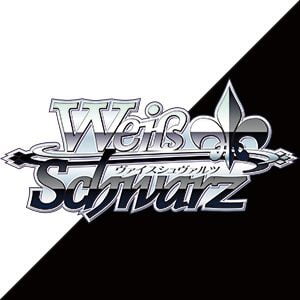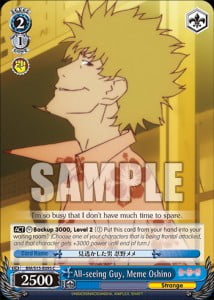‘Weiss Schwarz’ offers a promising alternative to ‘Magic: The Gathering’
Published By: Simeon Cortezano on February 6th, 2014

I’ve been playing “Magic: The Gathering” for a long time. Since I’ve been playing for so long, I have the tendency to compare many other card games I try to “M:TG” and cause myself to dislike them. However, there have been a couple of games that managed to spark and keep my interest. There was the “World of Warcraft” TCG by Cryptozoic and “RAW Deal” by Comic Images. After this past weekend, I can gladly add another game to that list: “Weiss Schwarz.”
About “Weiss Schwarz”
“Weiss Schwarz” is a Japanese collectible card game that is published by Bushiroad. If you’ve been to the Abington store, you’ve probably notice a few of the regulars playing it. They’re the cards with the cartoon-looking girls with big eyes, big smiles, and bright personalities. Some people also call this animation style: Anime. A lot of the art is based off of popular Japanese anime shows such as “Sword Art Online,” “Fairy Tail,” and “Fate/Zero” to name a few.

The rules and mechanics of the game are not hard to understand. In fact, I was able to pick it up in about 15 minutes. However, if you’re completely new to the world of collectible card games, it may take a little longer to pick up. You can rest assured, though, that it’s nothing complicated like learning how to play “Magic: The Gathering.”
Your deck is the source of all life
So why does “Weiss Schwarz” make my short list of playable CCGs? A mechanic that “RAW Deal” and this game have in common is that your deck is your life total…essentially. There are slight differences though. In “RAW Deal,” as you took damage from your opponent, you would flip cards from your deck (also known as your “Arsenal”) and placed them into your graveyard. A winner would be declared when someone couldn’t “overturn cards from his or her Arsenal when required to, or when [someone] has no cards at the end of any turn.”
When players take damage in “Weiss Schwarz,” the top card of their deck gets placed into an area known as the “clock.” These cards represent the amount of “time you have left to play the game.” Every time your clock reaches seven cards, you “go up one level.” When a player hits level four, they lose the game.
In “Magic: The Gathering,” players have five things to worry about: their hand, their deck, their graveyard, the battlefield, and their life total. In “Weiss Schwarz,” you have eight: your hand, your deck, the “waiting room,” the “clock,” the “center stage/back stage” area, the “stock” area, “climax” area when they are played, and your “memory.”
Since your deck is your life total and its contents are split into eight different areas, the dynamics of the game are changed drastically as opposed to when you’re playing “Magic: The Gathering.”
When I play “M:TG,” my life total, along with my opponent’s, is recorded on a separate sheet of paper. It goes up and it goes down. Whoever forces their opponent to zero life wins. By making your deck become your life source, I feel, makes for a more interactive game experience.
A break for your wallet
Let’s face it. the constructed side of “Magic: The Gathering” is a really expensive game to play and get into. I guess the same can be said about almost any game a person plays for a hobby, but just to stay competitive…well, let’s just say that it feels like you spend more to sometimes win less, at least at the local stage of the game. This is also not the fault of local game stores. You can blame the secondary market for some of the single prices, but if you’re good enough to make the Pro Tour and win, then kudos to you.
When I was learning to play “Weiss Schwarz” over the weekend, I was using a trial deck with a few additions made to it, and I did well against a “constructed” deck. These trial decks are the equivalent to intro packs for “M:TG.” However, trial decks are competitive right out of the box.
MTGGoldfish.com is a “Magic: The Gathering” financial website. It keeps track of prices and trends of online and paper “M:TG” cards. According to that site, the cheapest standard format deck will cost you almost $150. You don’t even want to know how much some of the top tier decks will cost.
“Weiss Schwarz” is significantly cheaper. Battleground Games & Hobbies sells the trial decks for $24.99 and booster packs for $5.99. Each trial deck comes with a 50 card pre-constructed deck, rule sheet, manual, play book, and playmat. The boosters may be a little more expensive than “M:TG” boosters, but you don’t need to add a lot to your deck right away. So it makes having to buy boosters a little more manageable.
Some final thoughts
I know I’ve made a lot of comparisons to “Magic: The Gathering” and, in some cases, I’ve made it sound like I enjoy this game more. However, that’s not the case. I’ve sold my collection twice and quit about four times. How does that make sense? I don’t know, but it’s the truth. I’ll always be a “M:TG” player, but it’s nice to find another game you can play and actually enjoy every now and then.
As of right now, Battleground Games & Hobbies has tournaments on Saturday afternoon. The format is rather loose until they establish a more solid player base and players get their hands on more cards.
When I was learning to play, I know that there were at least two or three other people learning as well, and a bit of a crowd watching. I’d like this game to pick up. It would be great to see more games being played at the store.
Join the Battleground Games & Hobbies community forums!
Please don’t forget to check us out on Facebook and follow us on Twitter @battleground_gh!




Social: